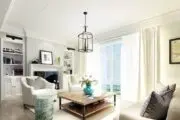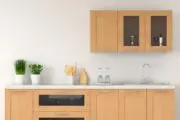Among the hottest interior design trends for 2024 is mixing metals. Mixing metal finishes and textures adds layers of substance to your style.
However, when mixing metals, it is important to strike the right balance: too many metallics, the wrong combination of metals, or improper placement within a space will make the aesthetic look haphazard, as opposed to curated and luxe.
Here is a guide on how to bring the bling the right way when mixing metals.
Why is mixing metals an effective design strategy?
Creating intentional contrast by mixing metals, including colors, textures and shapes, adds dimension and depth to a space. In addition to adding visual interest, it’s this extra layer of aesthetic power that lends warmth, especially important in open-concept floor plans, and in rooms where there tends to be lots of hard surfaces, such as kitchens and bathrooms.
When properly implemented, mixing metals emphasizes both harmony and balance from a design perspective, which provides greater impact, compared to a single finish or tone.
Metals that are trending
Which metals to choose? Here are some of the most popular, and what they bring to the decor.
Matte black
It’s timeless and adds a sultry, dramatic punch. It is versatile, commonly appearing prominently in various aesthetics, including farmhouse and more contemporary styles.
Copper
Copper not only adds a hint of warm reddish-orange color, it has natural antibacterial qualities, part of the reason why it experienced a revival post-pandemic as homeowners look to incorporate health and wellness at home. It is a popular choice for rustic interiors, as well as industrial-inspired decor.
Brass
Brass was a staple during the 1980s, again in the early 2000s, and is trending once again, proving its staying power. In addition to the classic polished brass that is well known, homeowners are using antique or brushed brass for additional texture and a natural-looking patina that adds warmth.
Grey Iron
Grey in general serves as an excellent neutral, and pewter, gunmetal and grey iron all create pleasant backdrops to support other metals and paint colors as well.
Chrome
Homeowners are likely most familiar with polished chrome, which has been a staple of modernist aesthetics. It’s sleek, futuristic and is eye-catching for focal points.
Stainless steel
Stainless steel is common in kitchens, thanks to the popularity of stainless-steel appliances. Additionally, stainless steel is growing in popularity as a countertop choice, as homeowners are gravitating towards alternatives to quartz. It’s also popular as a backsplash.
Nickel
Nickel, particularly polished nickel, offers a lot of the same blingy, reflective pizzazz that both stainless steel and chrome offer. Brushed nickel is a dialed-down stainless-steel look, a good choice for a secondary metal. Nickel is a cool, contemplative option, popular in transitional styles.
Bronze
Richer than brass and copper, the weathered look of aged bronze is a special way to infuse color and warmth into a room. It is a good choice for accents.
Gold
Gold is warm, classic and adds a touch of glamor. Its versatility lends itself to numerous aesthetics and is a reliable choice for homeowners who are beginning to experiment with metals.
Limit your metal selections
While mixing metals adds visual interest in a space, mixing too many metals creates visual chaos.
But how many metal choices are the right amount?
The general advice is to first consider the size of the space, and then limit yourself accordingly. Choose no more than two metals in a smaller room and no more than three in a larger room.
Distribution and balance matters in creating the overall effect as well. Spread them out across the room. Although balance is the goal, don’t split your metal selections 50/50 (or in thirds, if you have three).
Ideally, you would select a dominant metal and then use your second choice as an accent, or if you are using three, a dominant, secondary and accent.
Follow the same rule used in paint color application: 60/30/10 ratio. 60 percent of your metals are dedicated to your dominant metal, with 30 to a secondary metal, and then 10 to an accent metal.
If you are using two metals, have your primary choice occupy 60-70 percent, with the remainder for accents.
Use the available space to spread metals out, rather than clustering them in one spot.
Start by choosing a dominant metal
“Similar to choosing a dominant or base color when selecting a color palette, it’s helpful to have a primary metal as sort of a guidepost,” says designer Kathy Kuo of Kathy Kuo Home.
“From there, don’t be afraid to mix warm and cool metals, and think beyond the classic gold and silver,” she says.
Matte black and grey metals (pewter, gunmetal and iron) are considered some of the most popular neutrals, so if you aren’t sure where to start, choosing one of these as your dominant metal can be helpful. You can try various accent metals to see what combinations appeal the most more easily.
“You’ll find that metallics like natural iron and burnished brass can really function as neutrals and they give you a lot of latitude to mix metals in a way that feels cohesive and not overly flashy,” says Kuo.
How do mixed metals get applied in specific rooms?
What are some practical examples on how to divide and balance metal choices?
In a kitchen, you might choose your dominant metal for the light fixtures, larger plumbing fixtures and range hood, and assign an accent metal for your drawer pulls and cabinetry hardware.
In a bathroom, your plumbing fixtures might be dedicated to one metal choice, with accents applied to mirror trim and other decor.
Remember texture when mixing metals
Kuo says,” When mixing metals, keep texture in mind to create intentional contrast. You can even mix textures within the same metal family for a really dynamic look.”
Texture matters when mixing metals almost as much as color choice, as mingling different textures will either act cohesively, or make your choices feel competitive to each other, rather than complementary, in the aesthetic,
“Metal textures—hammered, polished, and matte—function similarly to how different fabrics do in the upholstery world,” Kuo explains, where different textures are incorporated for variety and a visual/tactile experience of the design.
Helpful hints and design inspiration for mixing metals
What are some of the trending mixed metal combinations? There are numerous possibilities, but here are some popular ones:
- Matte black and brass
- Brushed nickel and copper
- Brass and polished nickel
- Chrome and brushed bronze
- Bronze and brass
- Gold, brass and natural iron
Kuo loves “the more subtle metallics, and my favorite metal is pewter. The combination of pewter with copper and brass is a lovely mix of shine and burnish and the effect is very much in line with the popular Quiet Luxury and Dark Academia trends.”
Here are some more helpful tips when mixing metals:
- For fixtures with the same use, keep finishes the same (i.e. a tub filler and showerhead should be the same in a shower/tub combination).
- Be aware of lighting in a room, as some metals are very reflective, while others are more subdued, and this will influence the overall look and feel of the mixed metals.
- Remember temperature undertones in addition to color and texture. For example, brass, copper and gold are warm with orange/red undertones, while stainless steel and chrome have blue undertones, so cooler. Be careful when combining warm with cool metals.









